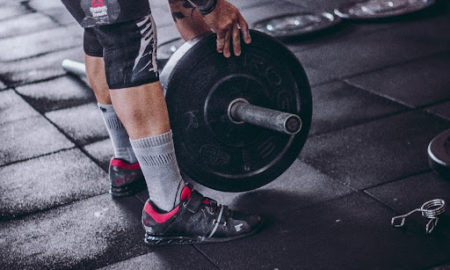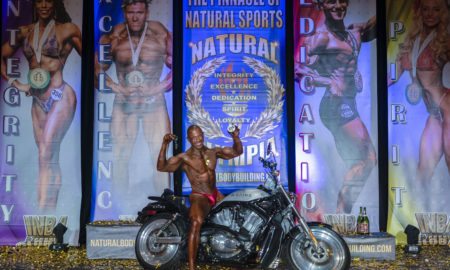It was a statement that flew in the face of conventional bodybuilding wisdom: "You want to flip it around. Do bench press last. Your ego might suffer a little, but your chest won’t."
Up until that point my chest-training interview with NPC national-level welterweight Alex Azarian was moving along as normal. Get the movements, establish the philosophy, a few pieces of personal information and—bang! It’s very rare that something unique comes along and challenges everything you’ve previously known about bodybuilding.
Bench press last? Really? Once Alex explains his theory, however, it makes perfect sense.
First, a Word or Two About Alex
If you recognize the name Azarian, it’s probably because you’re a fan of bodybuilding, you’re a loyal reader of IRON MAN, where Alex has made several appearances, or you’ve seen the photographs taken by Alex’s talented wife Nga, who, besides being the mother of the couple’s one-year-old son, Steven, is the official contest photographer for California uber-promoter Jon Lindsay. Since emerging on the scene a few years back, Alex has been known for a couple of things: 1) some amazing precontest photos and 2) having one of the better developed chests among his fellow competitors. While his placings have been mixed—mostly to do with the plethora of problems involved in peaking on contest day—his training and contest-prep business, www.PrepByAlex.com, has been churning out winner after winner on the NPC California circuit, including ’10 Tournament of Champions superheavyweight champ Mike Weitzman.
In addition, Alex is very easy to talk with. Unlike some competitors, who enjoy working out but don’t relish talking about working out, Alex comes alive when the subject is training. It was that drive that led to the above comment, which took our chest discussion down a totally different path.
Flip It
There are two schools of thought about training routines. The first is that you have a set-in-stone program that you follow to a tee, never deviating except for increased workload or when you reach a plateau. The second school is a little more obscure: You don’t need a regimented workout, just a few basic moves that you key off and constantly switch around to keep the body off balance and avoid plateaus.
Obviously, Alex’s training philosophy is from the latter school. When it comes to chest work—his choices are remarkably basic, compound movements that bodybuilders have been doing for years. What’s different is the way he structures his routine.
"For years I would hit the gym on chest day and head straight to the flat bench," Alex admits. "Bench press, flat then incline; followed by flyes, flat then incline; followed by bodyweight dips—workout finished." Eventually, he hit a plateau and decided to see what would happen if he changed the order.
"So I decided to do dips first, flat-bench presses last. After my ego was crushed, I noticed that my chest was 100 percent fried."
Bench presses 3 x 10-12
Incline presses 3 x 10-12
Flat-bench flyes 3 x 10-12
Incline flyes 3 x 10-12
Dips (bodyweight) 2 x 10-12, 1 x max
A “flipped” workout would look something like this:
Incline flyes 3 x 10-12
Flat-bench flyes 3 x 10-12
Incline presses 3 x 10-12
Bench presses 3 x 10-12
Dips (bodyweight) 2 x 10-12, 1 x max
Note: There’s no specific order to a workout flip. The key is to do the workouts in a different order from what you’re used to.
Two caveats here:
1) If you’re going to try this, don’t get too concerned about the pounds you lift. Alex is quick to point out that he’s not "powerlifter strong" on bench presses, nor does he want to be. For a bodybuilder the goal of most workouts is to gain mass. Yes, you have to lift heavy (when Alex was in high school, he weighed 150 pounds and was doing 300-pound bench presses), but you’re not trying to lift so heavy that you lose form and your front delts take over. If you’re benching near the end of your workout, you have to get used to lifting less, not more.
2) You don’t "flip" every time. This works best as an occasional tactic. Ninety percent of the time you do the basic bench presses, then incline-bench presses, then flyes, etc. It’s the other 10 percent of the time that will be different—and it could help you get over a plateau. If you change everything around all of the time, you’ll lose the shock effect.
Also important to remember: When you flip your chest training, your chest is going to be fatigued. The body’s default reaction will be to recruit surrounding bodyparts to join in. Focusing on form is the only way to ensure that it doesn’t happen. The key is to maintain a nice, smooth rep speed—no bouncing—and use a good grip that makes it harder for the delts or triceps to become the lead actor. It’s your chest that you’re trying to build, not your delts or triceps. You can build those on shoulder and arm day.
Alex is a big believer in picking the exercises that fit you. While his workout is focused on compound movements and free weights, you might get a better chest workout using machines. Whatever you do, just make sure you’re doing it right, doing it consistently and moving enough weight to stimulate growth. Alex believes that it’s a waste of effort for bodybuilders to focus on one-rep maxes. That not only requires spotters—which he rarely trains with—but also can lead to injury and does little in the way of building size. If you have to know what your numbers are, find your three-rep max and use a conversion table like those found at XplosiveSpeed.com.
To Dip or Not to Dip?
Bodyweight dips are one of the best chest finishers available, but a lot of people are concerned about injuries. Alex feels that using proper form—leaning slightly forward—takes a lot of the stress off of the delts and is an effective way to burn out the chest muscles at the end of a workout. Even so, he doesn’t see the need for adding weight to dips, since he feels that it just leads to poor form. Even if you’re flipping your workout and doing dips first, consider them a warmup exercise. If you’re finishing with them, and you’ve done the workout correctly, it should be impossible to use anything more than your bodyweight. If you’re still not comfortable with bodyweight dips, Alex suggests trying pushups as a finisher.
"The good thing about pushups is that you don’t need any equipment and there are many variations," he says. That’s also good advice for those who travel frequently and may not have access to good gyms. Almost every hotel gym in America has a flat bench, dumbbells and floor space. That’s pretty much all you need to get in a good chest workout.
Many of us would love to have better chest development. It’s one of those bodyparts that are prominent but are not the easiest to isolate. For Alex, however, chest comes easy. In fact, it’s one of the bodyparts he considers to be markers when judging his precontest condition. He tends to carry some fat in his chest, so when his side-chest pose is on, he’s pretty much sure he’s done the work.
Alex took off 2010 to make improvements in his physique and enjoy the benefits of fatherhood. He’s now ready to get back into the game at the ’11 NPC USA Bodybuilding Championships in Las Vegas in July. In the interim you might see his face in a Xenadrine ad or bringing another competitor into a show on point. What you won’t see him doing is slowing down or getting into a rut. He’d rather flip.
Editor’s note: To contact Alex Azarian for contest prep or training, go to www.PrepByAlex.com or write to him at [email protected]. IM
















You must be logged in to post a comment Login